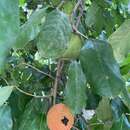ar
الأسماء في صفحات التنقل


Napoleonaea imperialis is a small, evergreen tropical West African tree in the family Lecythidaceae, native to Africa.[2]
It grows to some 6m in height, with a dense, low-branching crown, and occurs from Benin, Nigeria, Gabon and the Democratic Republic of the Congo southwards to Angola. The showy flowers have two inner rows of petals and vary in colour, usually creamy yellow along the circumference, with the center ranging from red to apricot to purple - they develop either on young branches or grow directly from the old wood of the trunk. The fruit is a berry, dark orange or reddish-brown containing a kidney-shaped seed. This species is popularly cultivated as an ornamental tree.[3]
The species was described in 1804, the same year its namesake (Napoleone di Buonaparte) crowned himself Emperor of the French.[4][5]
Extracts from the leaves and toxic seeds display bactericidal activity and contain various glycosides, tannins, proteins and saponins, while flavonoids, resins and steroids are absent.
Escherichia coli, Bacillus subtilis and Pseudomonas aeruginosa are inhibited, justifying the use of the species in tribal pharmacology. The bark and fruit pulp are chewed to alleviate pulmonary problems. Analysis of the seeds revealed the presence of napoleogenol, napoleogenin (Kapundu et al., 1980), napoleonaside, and a molluscicidal saponin.[6][7]
Napoleonaea imperialis is a small, evergreen tropical West African tree in the family Lecythidaceae, native to Africa.
It grows to some 6m in height, with a dense, low-branching crown, and occurs from Benin, Nigeria, Gabon and the Democratic Republic of the Congo southwards to Angola. The showy flowers have two inner rows of petals and vary in colour, usually creamy yellow along the circumference, with the center ranging from red to apricot to purple - they develop either on young branches or grow directly from the old wood of the trunk. The fruit is a berry, dark orange or reddish-brown containing a kidney-shaped seed. This species is popularly cultivated as an ornamental tree.
The species was described in 1804, the same year its namesake (Napoleone di Buonaparte) crowned himself Emperor of the French.
Napoleonaea imperialis, la napoléone impériale, est une espèce de plantes dicotylédones de la famille des Lecythidaceae, originaire d'Afrique de l'Ouest.
C'est un petit arbre tropical sempervirent, qui peut atteindre 6 mètres de haut[2] Il présente un houppier dense, avec des ramifications basses. Les fleurs voyantes ont deux verticilles internes de pétales de couleur variable, généralement jaune crème à la circonférence, le centre variant du rouge abricot au pourpre. Elles se développent sur de jeunes rameaux ou poussent directement sur le vieux bois du tronc (phénomène de cauliflorie). Le fruit est une baie orange foncé ou brun rougeâtre contenant des graines réniformes. Cette plante est largement cultivée comme arbre d'ornement[3].
C'est une espèce qui se rencontre au Bénin, au Nigeria, au Gabon et en République démocratique du Congo jusqu'en Angola vers le sud.
L'espèce a été décrite par Ambroise Marie François Joseph Palisot de Beauvois en 1804, année du couronnement de Napoléon Bonaparte[4],[5].
Selon Catalogue of Life (2 décembre 2017)[6] :
Feuillage de N. imperialis dans le jardin botanique de Peradeniya dans la banlieue proche de Kandy au Sri-Lanka.
Napoleonaea imperialis, la napoléone impériale, est une espèce de plantes dicotylédones de la famille des Lecythidaceae, originaire d'Afrique de l'Ouest.
C'est un petit arbre tropical sempervirent, qui peut atteindre 6 mètres de haut Il présente un houppier dense, avec des ramifications basses. Les fleurs voyantes ont deux verticilles internes de pétales de couleur variable, généralement jaune crème à la circonférence, le centre variant du rouge abricot au pourpre. Elles se développent sur de jeunes rameaux ou poussent directement sur le vieux bois du tronc (phénomène de cauliflorie). Le fruit est une baie orange foncé ou brun rougeâtre contenant des graines réniformes. Cette plante est largement cultivée comme arbre d'ornement.
C'est une espèce qui se rencontre au Bénin, au Nigeria, au Gabon et en République démocratique du Congo jusqu'en Angola vers le sud.
L'espèce a été décrite par Ambroise Marie François Joseph Palisot de Beauvois en 1804, année du couronnement de Napoléon Bonaparte,.
Napoleonaea imperialis là một loài thực vật có hoa trong họ Lecythidaceae. Loài này được P.Beauv. mô tả khoa học đầu tiên năm 1804.[1]
Napoleonaea imperialis là một loài thực vật có hoa trong họ Lecythidaceae. Loài này được P.Beauv. mô tả khoa học đầu tiên năm 1804.